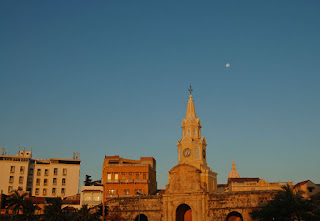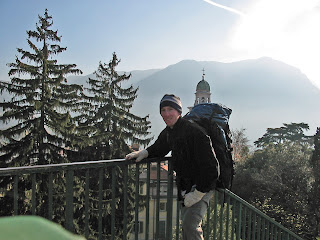
Well everyone, as most of you know, I have returned back to Salt Lake City from Colombia now, but have yet to write my final blogpost about my time on the coast. So after getting reacquainted with the snow and cold here, I am finally ready to do so. So here it goes....
After my amazing week in San Gil, I flew to Santa Marta, a large city on the Caribbean coast of Colombia. Considering the incredible times I had in the smaller, less-touristy towns of Santander and Boyaca, I decided to stay out of Santa Marta for the most part, and spend my time in Taganga, a little fishing village about 15 minutes from the big city. Wo
 w, this decision turned out to be a great one!
w, this decision turned out to be a great one!Taganga is a cozy little fishing village located in a valley between mountains, settling into the coastal landscape with its own bay. It brought back a few memories of Madagascar and the fishing villages I lived in there, although those were much poorer, less developed, and "true" fishing villages in the sense that the only thing that occurred in these villages was fishing. Anyway, after walking around the little town for awhile, carrying my backpack and asking the locals about all the possible places to stay, an older gentleman directed me to a really cool hostel overlooking the bay. The hostel was run by a friendly American couple, and offered a sweet rooftop terrace and bar with hammocks and everything else. Like all places along the Caribbean coast, Taganga was pretty hot and the rooftop terrace proved to be a lifesaver, especially with the famous Taganga winds blowing all afternoon and evening. The sunsets from the harbor were also very beautiful.
While in Taganga, I met a very nice lady who ran a little eating establishment out of her home. I ended up eating there every night I spent in the little village, and also met her two boys, who taught me a new card game, and made it somewhat difficult for me to eat my dinners, between all the cheering and dealing going on in our high stakes games.
From Taganga, I tr
 aveled to the incredible Parque Tayrona, a coastal national park full of beautiful beaches and gorgeous mountains, including the Sierra Nevadas de Santa Marta, one of the highest coastal mountain ranges in the world. It was about a two-hour hike through the jungle and then along the beach to arrive at Cabo San Juan, one of the last accessible beaches along the park's interior. Cabo had a calm bay and a great beach for relaxing and swimming, along with a little bar and cafeteria to buy food and drinks. After trying to arrange to sleep in one of the hammocks high above the rocks of the bay and finding out that they were all full, I decided to ask about the other hammocks that were still free. I talked to a guy who had spent the previous night in these hammocks, and after he showed me the 75 or more mosquito bites along his one arm that he had acquired the night before while sleeping, I decided against staying the night in those horrendous c
aveled to the incredible Parque Tayrona, a coastal national park full of beautiful beaches and gorgeous mountains, including the Sierra Nevadas de Santa Marta, one of the highest coastal mountain ranges in the world. It was about a two-hour hike through the jungle and then along the beach to arrive at Cabo San Juan, one of the last accessible beaches along the park's interior. Cabo had a calm bay and a great beach for relaxing and swimming, along with a little bar and cafeteria to buy food and drinks. After trying to arrange to sleep in one of the hammocks high above the rocks of the bay and finding out that they were all full, I decided to ask about the other hammocks that were still free. I talked to a guy who had spent the previous night in these hammocks, and after he showed me the 75 or more mosquito bites along his one arm that he had acquired the night before while sleeping, I decided against staying the night in those horrendous c ontraptions and instead, set my backpack down on the deck of the gazebo high above the water, and ended up sleeping (okay, I actually didn't sleep a minute that night) while sitting in a chair on the gazebo. I guess the weather wanted to punish me for not paying for a hammock because it rained on me for about 2 hours during the night. Although it was very miserable and one of the longest nights of my life, there was something cool about sitting there in the dark, all alone, and just watching the ocean do its thing while listening to the waves crash up against the rocks. I was very happy to see the sun come up though, and then to hike back out and get back to Taganga.
ontraptions and instead, set my backpack down on the deck of the gazebo high above the water, and ended up sleeping (okay, I actually didn't sleep a minute that night) while sitting in a chair on the gazebo. I guess the weather wanted to punish me for not paying for a hammock because it rained on me for about 2 hours during the night. Although it was very miserable and one of the longest nights of my life, there was something cool about sitting there in the dark, all alone, and just watching the ocean do its thing while listening to the waves crash up against the rocks. I was very happy to see the sun come up though, and then to hike back out and get back to Taganga.After another day in Taganga, I took a bus over to the jewel of Colombia, or at least in the tourists' eyes, Cartagena. I stayed in the Getsemani area of Cartagena, where many of the hostels and tourist attractions are located, just outside the Old Town. The first thing that struck me about Cartagena was the heat. It was very, very hot and very, very humid. I arrived in the evening, so I didn't get a true idea of the heat and humidity until the n
 ext day.
ext day.The Old Town, which is really the only photographed area of the city, is very pretty. It is a treasure trove of colonial architecture, cobbled streets, horse-drawn carriages, and festive cultural plazas and performances. It was really nice walking around the Old Town at night, after the blazing sun had decided to rest for the day, and while the bright and colorful lights illuminated the colonial architecture and the dance groups came out to show off their moves in many of the several plazas. I actually came across a charity concert that was being held in one of the main squares of the city, and after befriending a security guard, was offered free entrance into the concert. However, because it was an international, black-tie event (concert for a Landmine-Free World), and I was wearing shorts (although they were nice shorts:) and a t-shirt, I decided not to spend much time there, for fear of attracting attention because of my stylish wardrob
 e. I did get to see Juanes, a famous Colombian music artist, perform a few songs, which was really fun.
e. I did get to see Juanes, a famous Colombian music artist, perform a few songs, which was really fun.While in Cartagena, I decided not to do the typical tourist thing and run all over like a chicken with its head cut off. I did not even look at my guidebook, but spent all my time just wondering around the Old Town, being totally spontaneous, and visiting the places that seemed to be the most "local" around. I enjoyed visiting the little food stands along the water, sampling ceviche (think of a type of raw fish stew), popping my head into the various little markets, and talking to completely random people. I was very surprised to find that outside of the Old Town, Cartagena seemed to be a very poor, rundown city. It reminded me a lot of Cairo, with the magnificent Pyramids standing just outside a city of filth and garbage. While walking around some of the areas outside of the tourist center, I probably felt the least safe in these areas than in any other area I visited during my trip. I know that within 5 hours of arriving in Cartagena, I was offered cocaine at least 20 times, approached by 4 or 5 prostitutes, and had one guy approach me like he wanted to fight. It was very interesting and I never knew what to expect next.
It was strange seeing the street markets start to fill with Christmas trees and other holiday items, while I was sweating profusely and trying to find some respite from the relentless heat. I guess some people can get into the Christmas spirit in a place like this, but not me. I need snow, cold, mountains, and all that stuff that I find back home in Salt Lake. Most importantly though, I need family and friends around me to make the holiday season special. At the end of my trip, I was very grateful that I had had the opportunity to see so much of this beautiful country that has been painted in a tarnished fashion by the media for so long. I was able to see for myself that there is so much more to Colombia than FARC, cocaine, kidnappings, and murder. There are beautiful people, diverse landscapes, dancing like nothing you have seen before, bustling metropolitan cities, relaxing towns and villages, and memories to last a lifetime. In summary, the national motto of Colombia says it best: "El riesgo es que te quieras quedar," or "The risk is wanting to stay."
Thanks to everyone for joining me on this Colombian adventure, and I am sure another adventure will be following soon:)
Final Pictures---
Parque Tayrona: http://www.photoworks.com/
Cartagena: http://www.photoworks.com/
.JPG)
.JPG)
.JPG)
.JPG)
.JPG)


























+109_edited-1.jpg)